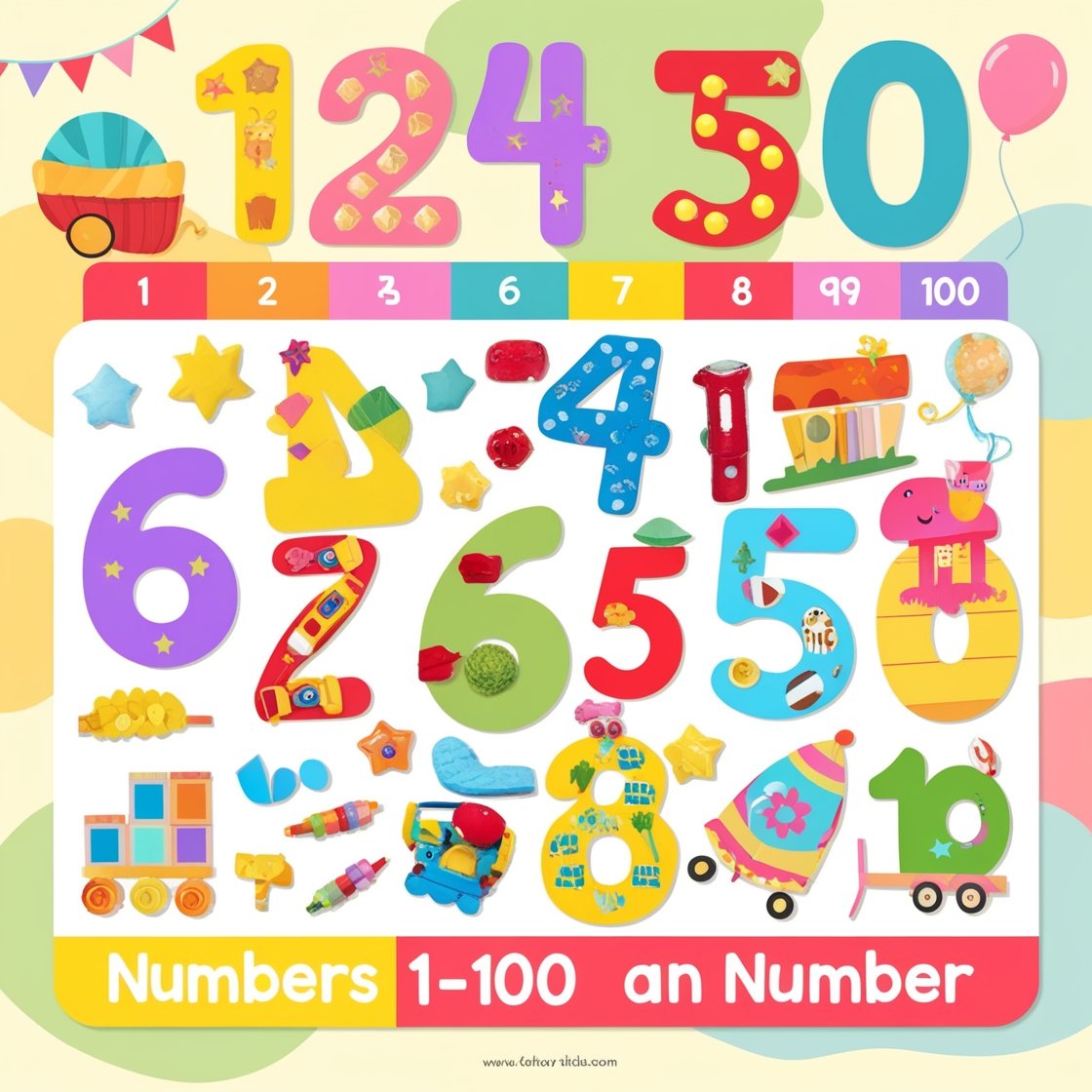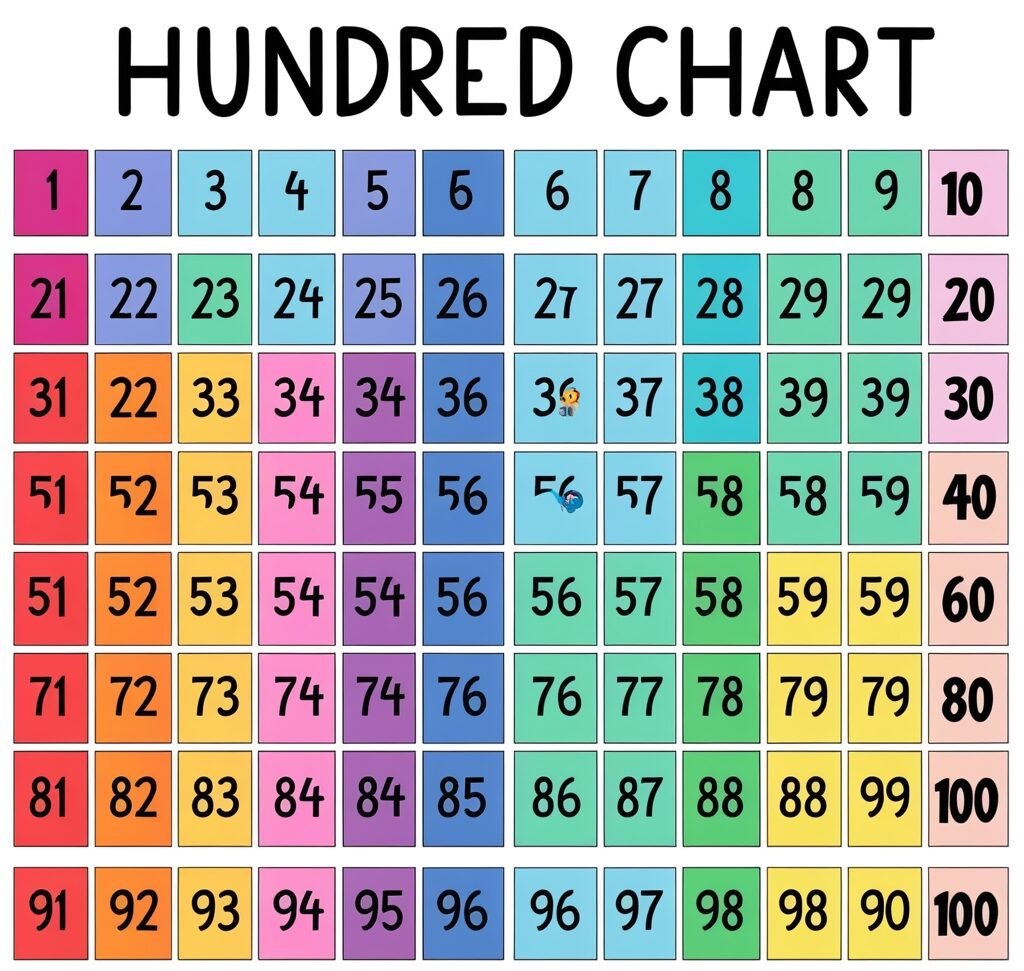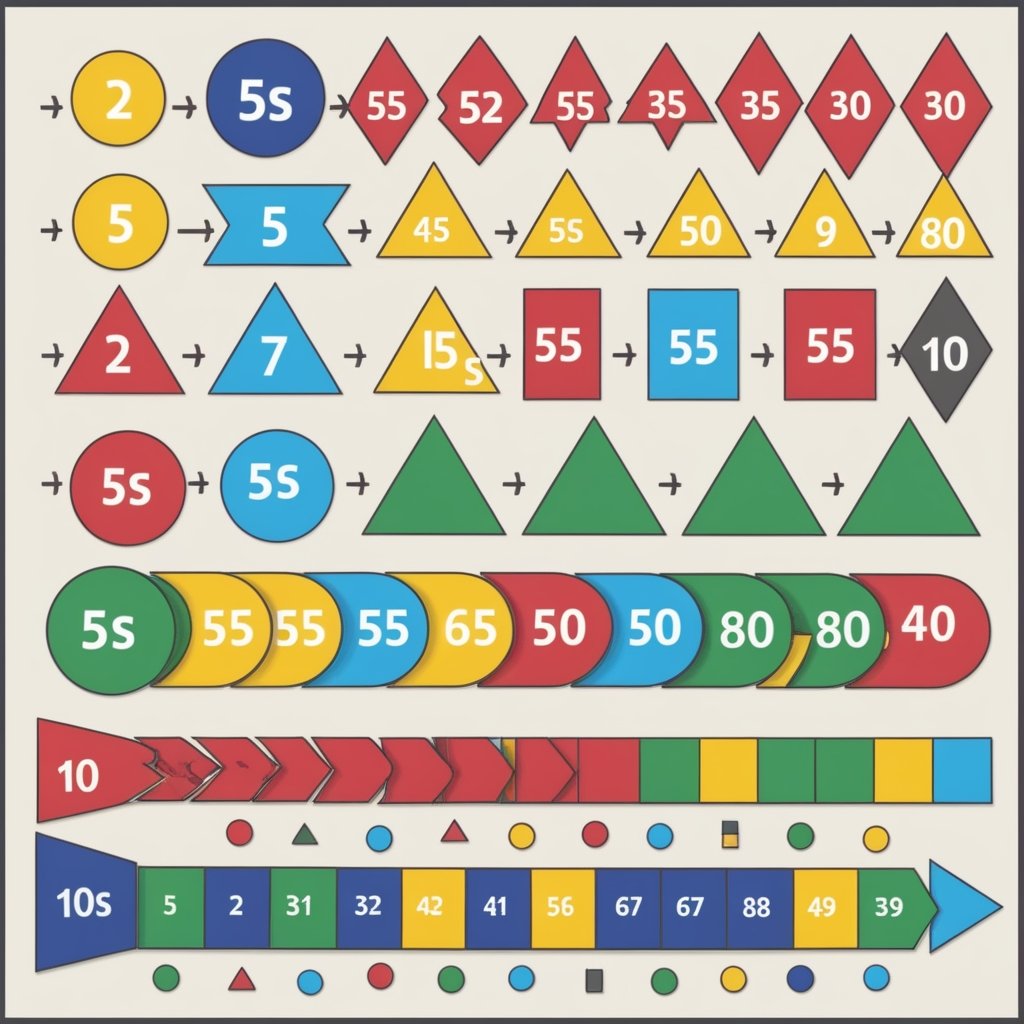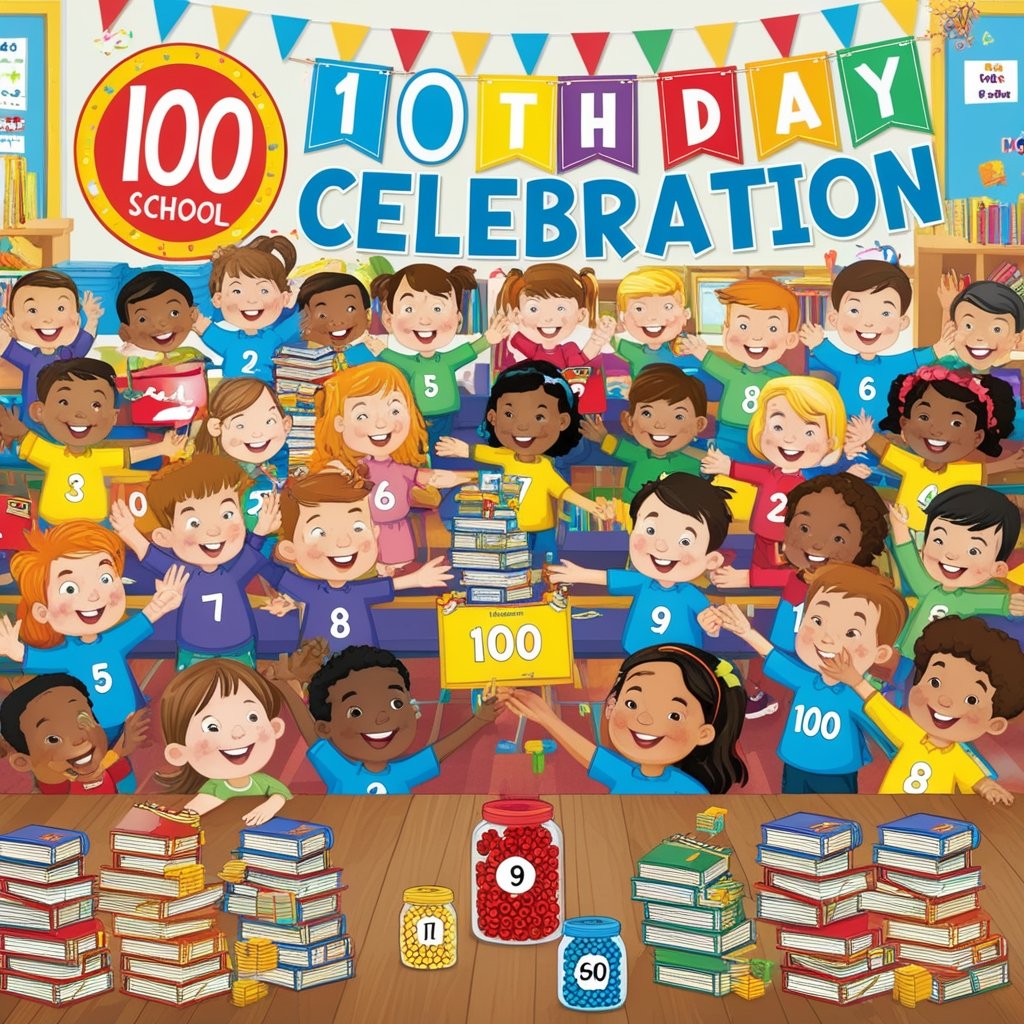Learn Numbers This shows how important it is to learn these basic math skills early on. It’s key for young kids to get good at counting and understanding numbers as they start their math adventures.
This guide will show you how to make learning numbers 1 to 100 easy and fun. It’s perfect for parents, teachers, or anyone who cares for young kids. You’ll find easy tips and fun activities to make counting fun for your little ones.

Numbers 1-100 Visualization
Key Takeaways
- Mastering numeracy skills from 1-100 lays a strong foundation for future mathematical success.
- Incorporating hands-on learning, interactive games, and visual aids can make counting and number recognition fun and engaging.
- Understanding number patterns, sequences, and place value concepts is crucial for developing a deep understanding of the number system.
- Celebrating milestones like the 100th day of school can reinforce counting and number recognition skills.
- Regular practice and positive reinforcement are key to helping children learn and retain number concepts.
The Importance of Learning Numbers 1-100
Learning to count from 1 to 100 is a key step in a child’s early math journey. It’s the base for better number recognition, counting practice, and numeracy skills. These skills are crucial for doing well in early childhood education and later on.
Building a Strong Foundation for Math
Counting to 100 is a basic preschool math concept that helps kids understand early math concepts and preschool learning. As they move up in kindergarten math and higher, this skill is key. It helps them grasp more complex math fundamentals and early math skills.
Developing Number Sense and Counting Skills
Regular counting practice builds a strong number sense in kids. This lets them see how numbers and quantities relate. Through fun preschool math activities, young ones can develop a strong numeracy development. This will help them in school and beyond.
| Key Findings | Impact on Learning |
|---|---|
| 8 out of 23 students were still unable to count to 100 successfully without assistance. | Highlights the need for targeted interventions and continuous practice to ensure mastery of counting skills. |
| 4 out of 23 students continued to struggle with comprehending the counting pattern to 100 even after interventions. | Emphasizes the importance of using a variety of teaching methods and strategies to cater to diverse learning styles. |
| The bingo game “What Comes Next?” was mentioned as a hit among the students, indicating a high level of engagement with the activity. | Demonstrates the effectiveness of incorporating fun, interactive games to reinforce counting skills and keep students motivated. |
By focusing on early mathematics skills, like counting to 100, educators and parents can set kids up for success. This builds a strong base for their future academic achievements and keeps them excited about learning.
Fun and Engaging Activities for Counting to 100
Learning to count from 1 to 100 is key for math skills. Teachers use engaging and interactive activities to make learning fun. These activities spark students’ curiosity and love for learning.
Hands-On Learning with Manipulatives
Using hands-on learning with manipulatives like popsicle sticks or blocks is effective. These objects help students count by seeing and touching numbers. For example, “Spill the Beans” makes counting fun by using jelly beans in groups of 10.
Interactive Games and Songs
Interactive games and counting songs also help students stay focused and engaged. Games like “Traveling to 100” get students involved in learning. Singing counting songs helps students remember numbers and their order.
Combining educational games, interactive activities, and gamified approaches makes learning to count fun. This makes the process memorable for students.
“Using math routines like counting every day through singing, dancing, or videos can enhance counting skills.”
Using a Hundred Chart to Learn Numbers 1-100
Learning numbers 1-100 is key in early math. The hundred chart is a great tool for this. It makes counting fun and helps students understand numbers better.
Start by labeling 100 Unifix cubes with numbers 0-99 or 1-100. This takes about 10 minutes. Then, students count up to 100 with the cubes, making a number line.
As they work, students talk and help each other. They see how the chart helps them understand numbers up to 100.
But, the full number line is too long for one person. Students break it into smaller parts, focusing on groups of ten. This leads to the hundred chart, with cubes in rows of ten.
Switching from the number line to the hundred chart helps students get the idea. Building and comparing the models deepens their understanding of number recognition, counting practice, and numeracy development skills.
- Prepare a hundred chart by labelling 100 Unifix cubes with numbers 0-99 or 1-100.
- Assemble the cubes into a number line and have students count sequentially up to 100.
- Discuss the helpfulness of the number line and explore ways to make it more manageable, such as breaking it into sections of ten.
- Transition to the paper’s hundred charts, comparing the physical model to the abstract representation.
- Engage students in interactive activities like filling in missing numbers, skip counting, and solving riddles using the hundred chart.
The hundred chart is great for first and second-graders. It’s useful for preschool math and kindergarten math skills. It offers a visual and hands-on way to learn math fundamentals and early math skills.
“The hundred chart is an essential tool for building a solid foundation in numeracy development and number recognition. Its engaging activities make counting practice fun and meaningful for young learners.”
Counting by 10s: A Step-by-Step Approach
Learning the basics of number recognition and counting practice is key for preschool and kindergarten math. Counting by 10s is a vital skill that helps with math fundamentals and early math skills. It also helps kids understand numbers better.
Grouping Objects into Tens
Using visual aids is a great way to teach counting by 10s. Create charts or displays with 10 objects in each group, like:
- Hands and feet (for grouping by 5s and 10s)
- Glasses (for grouping by 2s)
- Tricycles (for grouping by 3s)
This makes counting by 10s easier and fun for kids.
Reinforcing with Visual Aids
Adding a

Hundred Chart
hundred charts to your teaching tools is also helpful. Have kids color in numbers that are multiples of 10. This activity helps them see patterns and understand counting by 10s better. It also introduces them to the hundred charts, a useful tool for learning about numbers.
By using these fun counting practice methods, you can help kids get better at number recognition. This builds a strong base for more complex math fundamentals and numeracy development.
Recognizing Number Patterns and Sequences
Teaching number recognition, counting practice, and early math skills is key. It’s important to help students spot number patterns and sequences. This strengthens numeracy development and prepares them for more complex preschool math and kindergarten math topics.
Spotting Patterns on the Hundred Chart
The hundred chart is a great tool for learning number patterns. By using it often, students can see different math fundamentals. These include:
- Counting by 10s (10, 20, 30, 40…)
- Identifying arithmetic patterns (adding a constant to each number)
- Spotting geometric patterns (multiplying by a constant)
- Recognizing square number and cube number patterns
- Observing triangular numbers and Fibonacci sequences
Practising with the hundred chart daily, like colouring or playing games, improves number recognition and counting skills. It also helps students understand number relationships and numeracy development by finding missing numbers or predicting the next in a sequence.
| Pattern Type | Example | Description |
|---|---|---|
| Arithmetic | 9, 18, 27, 36, 45, 54… | The common difference between consecutive numbers is 9. |
| Geometric | 3, 6, 12, 24, 48, 96… | The numbers are multiplied by a constant ratio of 2. |
| Square | 1, 4, 9, 16, 25, 36… | The numbers represent the sequence of perfect squares. |
| Cube | 1, 8, 27, 64, 125, 216… | The numbers represent the sequence of perfect cubes. |
| Triangular | 1, 3, 6, 10, 15, 21… | The numbers represent the sum of all integers from 1 to n. |
| Fibonacci | 1, 1, 2, 3, 5, 8, 13… | Each number is the sum of the two preceding numbers. |

Counting by 10s
By exploring these number patterns and sequences, students gain a deeper understanding of number relationships and math fundamentals. This prepares them for success in preschool math, kindergarten math, and beyond.
Ordering and Comparing Numbers
As young learners get better at number recognition and counting practice, it’s key to let them arrange numbers and compare them. This helps them improve their numeracy development. It also builds a strong base in preschool math and kindergarten math.
Activities for Ordering Numbers
Activities that make kids put numbers or objects with numbers on them in order to help them count and work on their number sense. As they get more familiar with numbers, they can better compare them.
- Use a number line as a visual aid to teach and practice ordering numbers.
- Ask children to point out or mark the numbers where they belong on the number line.
- Incorporate “the number of the day” math chats as a daily routine to reinforce counting, place value, and number ordering.
Comparing Numbers: Greater Than, Less Than
It’s important to give kids daily chances to compare numbers to make their math fundamentals and early math skills stronger. Encourage them to figure out which number is bigger, smaller, or the same using greater than ($\gt$), less than ($\lt$), and equal to ($=$).
“Comparison of numbers is a fundamental skill in early math development, laying the groundwork for more complex concepts like addition and subtraction.”
Visual aids like ten frames and anchor charts can help students remember what they’ve learned about ordering and comparing numbers.
By adding these fun activities and strategies to your preschool math or kindergarten math lessons, you can really help your students with their numeracy development and number recognition skills.
Introducing Place Value Concepts
As young learners move forward in their math fundamentals, grasping place value is key. This concept is vital for excelling in numeracy development and laying a strong base in early math skills.
Understanding Ones and Tens
The spot of a digit in a number sets its value. For example, in 345, the “5” is in the one’s place, meaning it’s worth 5. The “4” is in the tens place, so it’s worth 40 (4 tens). And the “3” is in the hundreds place, worth 300.
Zero is a placeholder, helping us tell apart numbers like one hundred-five and fifteen. Place value is key for number recognition, counting practice, and boosting preschool math and kindergarten math skills. It sets the stage for math operations, and mental math, and prepares students for harder topics.
| Concept | Importance |
|---|---|
| Ones and Tens | Distinguishing the value of digits based on their position in a number |
| Place Value | Crucial for building number sense, supporting math operations, and enhancing problem-solving skills |
| Zero as a Placeholder | Distinguishing between numbers like one hundred-five and fifteen |
By learning about ones and tens, students get a deeper understanding of math fundamentals. This helps them do well in numeracy development later on.

Number Patterns and Sequences
Celebrating the 100th Day of School
The 100th day of school is a big deal for teachers and students. It shows how much they’ve learned in the first half of the year. It’s a chance to celebrate preschool learning, early numeracy skills, preschool math, kindergarten math, and early math skills.
Teachers plan fun activities for this day. They include counting to 100 and doing 100-themed crafts. It’s a day for students to show off their preschool learning and early math skills.
One fun activity is the “When I Am 100 Years Old…” task. Students think about what they’ll do when they’re 100 and make a craft about it. This helps them be creative and understand the importance of the number 100.
| Activity | Description |
|---|---|
| Hershey’s Kisses Hunt | The teacher writes numbers 1-100 on the bottom of each Hershey’s Kisses, and students must hunt for the hidden candies to complete the sequence. |
| 100th Day Snack | Students put 10 snacks in each of the 10 circles on a placemat-sized mat, creating a total of 100 snacks. |
| Fruit Loops Necklace | Using ten frames and curling ribbons, students create a necklace with exactly 100 Fruit Loops. |
These activities make preschool math and early numeracy skills fun. They also help students work together, solve problems, and feel proud of their achievements.
The 100th day of school is a celebration of hard work and progress. By doing different preschool learning and kindergarten math activities, teachers make a special day. It helps students love learning and understand why early math skills are important.

100th Day of School Celebration
Counting Made Easy: Learn Numbers 1-100
Learning to count from 1 to 100 is key for kids’ early math skills. It’s the first step in building numeracy skills, number recognition, and counting practice. This sets the stage for success in math later on.
Studies show that kids need to see numbers often and learn through hands-on activities. Using a gamified approach and interactive activities makes learning numbers fun and easy for them.
| Skill Developed | Importance |
|---|---|
| Number Recognition | Recognizing numbers helps kids understand their values. |
| Counting Fluency | Learning numbers 1 to 100 builds strong early numeracy skills and counting practice. |
| Number Sense | Knowing how numbers relate to each other helps with early math concepts and preschool math. |
Fun activities like counting walks and number games make learning numbers fun. They help kids love early childhood education and preschool learning. These activities also help with kindergarten math and preschool math concepts.
The journey of counting made easy is more than just memorizing numbers. It’s about understanding numbers, patterns, and sequences. These skills are crucial for kids’ math skills and early numeracy skills development.
Reinforcing Number Recognition and Counting
Learning to recognize numbers and count is key for preschool and kindergarten students. These math skills are the building blocks for later success. Teachers use fun activities that mix reading, writing, and hands-on learning to help students.
Writing Numbers and Tracing Activities
Writing and tracing numbers is a great way to improve number recognition. It also helps with fine motor skills and hand-eye coordination. Teachers first show the right way to write numbers. Then, students get to practice tracing them on worksheets or a board with dry-erase markers.
- Encourage students to write numbers in different ways, like digits, words, and ten frames, to deepen their understanding of numbers.
- Try activities where kids trace numbers in sand, flour, or on a partner’s back for a hands-on learning experience.
- Use fun tools like number recognition puzzles, dominoes, and bingo boards to make tracing numbers fun and interactive.
These activities help improve number recognition and counting practice. They also boost math fundamentals, early math skills, and numeracy development.
| Activity | Description | Benefits |
|---|---|---|
| Counting Ice Cream Puzzles | Students match puzzle pieces to build an ice cream cone and count the scoops. | Reinforces number recognition, counting skills, and fine motor development. |
| Counting Bingo Boards | Children play bingo by marking numbers called out by the teacher. | Promotes active engagement, number identification, and number sense. |
| Number Identification Dominoes | Students match dominoes with the same number of dots or digits. | Enhances visual discrimination, pattern recognition, and number familiarity. |
“Mastering the foundational skills of number recognition and counting lays the groundwork for children’s success in mathematics throughout their academic journey.”
Assessing Progress and Mastery
Keeping an eye on your child’s number recognition and counting practice is key. It helps them get strong in math fundamentals and early math skills. Regular checks on their numeracy development show where they need more help. This lets you adjust how you teach them.
Hands-on activities and games are great for checking progress. For example, using blocks or beads to make ten groups of ten helps with counting practice. It also teaches about place value. Ask your child to count by 10s to 100 before moving to count by 1s.
Adding a hundred charts is also useful. It helps move from concrete math to understanding place values. As your child gets used to the hundred charts, they’ll get better at seeing number patterns and relationships.
- Use regular checks to see how your child is doing and find areas they need more help.
- Celebrate when your child can easily spot numbers in a range like 1-20.
- Have your child practice writing numbers, starting with the easy ones and then the harder ones.
- Play interactive games and do activities that make number recognition, counting practice, and other math fundamentals fun.
By often checking your child’s progress and celebrating their wins, you’re helping them lay a strong base in numeracy development. This gets them ready for future math success.
Conclusion
Learning to count from 1 to 100 is a big step in a child’s math journey. Fun activities like using a hundred chart and counting by 10s make learning numbers fun. This makes the process enjoyable for young learners.
Building strong numeracy skills and understanding early math is key to success in school. Hands-on learning with manipulatives and interactive educational games helps kids get better at recognizing numbers and counting. This is great for early childhood education.
Knowing how to count to 100 helps students with harder math in preschool and early grades. It boosts their learning and math skills. This prepares them for kindergarten math and sets them up for math success later on.
FAQ
What is the importance of learning numbers 1-100?
Learning numbers 1-100 is key to developing important math skills. It helps kids understand more complex math later on. Counting, identifying numbers, and knowing quantities are crucial skills that need practice.
What are some fun and engaging activities for learning to count to 100?
Using manipulatives like counting chips and blocks helps kids connect counting with real objects. Games, songs, and activities like “Around the World” make learning fun. They make numbers 1-100 more interesting.
How can a hundred chart help children learn numbers 1-100?
A hundred chart is great for learning to count to 100. It shows numbers in order and helps kids see patterns. This makes counting easier and more fun.
What is the importance of counting by 10s when learning numbers 1-100?
Counting by 10s is key for understanding place value. Using blocks and other aids helps kids see the connection between ones and tens. This is vital for learning numbers 1-100.
How can recognizing number patterns and sequences help in learning numbers 1-100?
Seeing patterns on the hundred chart helps kids understand numbers better. It makes counting to 100 easier and more intuitive. Spotting these patterns is important for math skills.
Why is it important to practice ordering and comparing numbers when learning numbers 1-100?
Ordering and comparing numbers builds a strong math sense. Activities that put numbers in order help kids understand numbers better. This is key for math success.
How can introducing place value concepts support learning numbers 1-100?
Understanding ones and tens is key for numbers 1-100. Using blocks and other aids helps kids see place value. This builds a strong math foundation.
Why is the 100th day of school a special celebration?
The 100th day marks a big achievement in school. Celebrating with a party and activities about the number 100 is fun. It reinforces kids’ math skills.
What are some effective ways to reinforce number recognition and counting skills?
Writing numbers and tracing helps kids practice their math skills. These activities provide more practice and make learning meaningful.
How can progress and mastery in learning numbers 1-100 be assessed?
Checking progress through observations and assessments helps teachers see what kids need. This guides teaching to make sure kids get a strong math foundation.







Leave a Comment